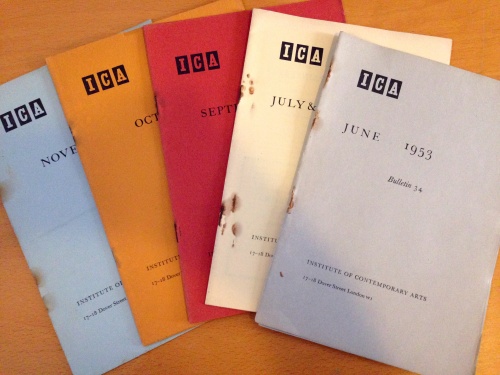Radical Art and the ICA
The Institute of Contemporary Arts - ICA’s - title reveals something very specific about the nature of what is contained on London’s The Mall. First, if taking the advice directly from the ICA, the Institute ‘is a site of research and analysis that does not have to be immediately visible but is continuously at work in the background’ (Pethick 2009: 251), implying that something quite radical could brew out onto The Mall at any moment (and might if given the opportunity).
As the ICA returns to its roots as a membership institution, it is important to note that the Institute was developed as a hub for artists (Phillips 1998), and ‘the ICA is nothing without its relationship to the artists, the musicians, the philosophers and filmmakers whose work still to this day can be classified under the heading of ‘daring experiment’ (Eshun and Jahn 2007: 6). Described as a ‘profound statement about influences and interrelations’ with a ‘poly-functioning exhibition space’ (ibid: 25), the Institute of Contemporary Arts is a vessel of not only the arts - music, film, and visual arts - that are contemporaneous, but the ideas, movements and events that influence them.
Even when still in its infancy, the ICA was described by former director Dorothy Morland as ‘like a railway station. People passed one another without realising that some would one day be famous and some would change the face of art beyond all recognition’ (Phillips 1998: 3). Early exhibitions foregrounded paradigm shifts in art, exhibitions, and society, some of which lay claims to flourishing into some of the ‘most important art movements of the twentieth century’ (Massey and Muir 2014: 5). The exhibition Growth and Form (1951) epitomised curator Richard Hamilton’s ideas about art and education, who later used notions from the exhibition to assign students ‘exercises that entailed the progressive development of elementary forms’ (Crippa 2013: 24). Responding to structures from the natural world (Moffatt 2010: 185), the exhibition explored how ‘complexities of art… are the products of involved psychology and intentionality,’ (Hamilton in Moffatt 2010: 186), joining art and science in a single display. The artworks, featuring natural and mathematical forms, disrupted a traditional notion of what belongs in an ‘art’ gallery. Another exhibition, Parallel of Art and Life (1953), was regarded as the ‘locus classicus’ (Banham 2013 [1955]: 11) of the new brutalism style of architecture, exemplifying the physical qualities that would spearhead the UK movement.
The ICA continues to encourage an active participation in its programme and discussions of contemporary art and life, from Culture Now, exploring the contemporary field of art and art theory, to Friday Salons, a contemporary twist on the traditional ‘salon’ talks format. It is symbolic that Day Membership returns with an exhibition of Hamilton’s work as we return to our roots as an organisation.
The ICA exists to ‘support radical art and culture,’ and it continues to do so through representing the contemporary - and so often non-canonical - forms that shape our understanding of art and the society we live in today.
Erin Johnson
Assistant Sales Manager - Membership
Crippa, E. (2013). ‘Basic Design and Exhibition Making’. In: E. Crippa and B. Williamson (Eds.), Basic Design. London: Tate Britain.
Eshun, E. and Jahn, P. (2007). How soon is Now? 60 Years of the Institute of Contemporary Arts. Institute of Contemporary Arts: London.
Massey, A. (1995). The Independent Group: Modernism and mass-culture in Britain, 1945–59. Manchester: Manchester University Press.
Massey, A. and Muir, G. (2014). Institute of Contemporary Arts: 1946-1968. London: Institute of Contemporary Arts and Amsterdam: Roma Publications.
Moffatt, I. (2010). ‘The Physiology of Thought: Neuroplasticity in Lancelot Law Whyte’s Model of ‘Unitary Thought’ and Richard Hamilton’s 1951 Growth and Form Exhibition’. In: S. Flach and J. Söffner (Eds.), Habitus in Habitat II: Other Sides of Cognition. Bern: Peter Lang AG International Academic Publishers.
Pethick, E. (2009). ‘Resisting institutionalisation’. In M. Sladen, R. Birkett, and I. Leaver-Yap (Eds.), Nought to Sixty: 60 projects/6 months. London: Institute of Contemporary Arts
Phillips, A. (1998). Fifty years of the future: A chronicle of the Institute of Contemporary Arts. Institute of Contemporary Arts: London.
This article is posted in: Articles, Members News
Tagged with: The Mall, membership





